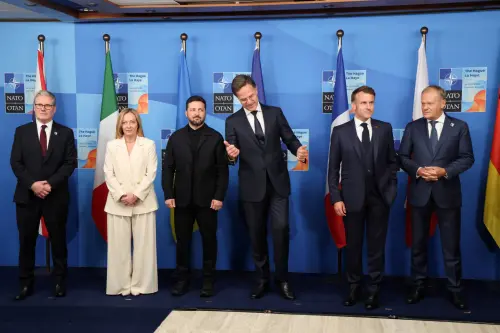With German Chancellor Angela Merkel still forming her new coalition government, it is impossible to say for certain what approach to integration Europe will take in the coming years. But reform of the EU and the eurozone will almost certainly not follow the highly ambitious path favored by European Commission President Jean-Claude Juncker. This piece originally appeared on Project Syndicate.
After a tumultuous year, politics seem to be stabilizing across Europe. Though the far-right Alternative für Deutschland (AfD) gained almost 13% of the vote in Germany’s recent federal election, it does not pose a serious threat to Chancellor Angela Merkel’s leadership. In France – the other pillar of the European project – President Emmanuel Macron can count on a solid parliamentary majority. And, despite the uncertainty surrounding the details of Brexit, there is little doubt that, whatever plans the European Union makes, it will be doing so without the United Kingdom as a member.
So now the question is how the EU and, in particular, the eurozone, will move forward. There are three possibilities.
The first option is a “more united union,” as described by European Commission President Jean-Claude Juncker in his state of the union address last month. Juncker’s vision rejects a multi-speed Europe, in favor of uniform steps by all EU members. This would mean, for starters, expanding the Schengen Area of border-free travel to include Bulgaria and Romania. Juncker also called for progress toward a European Social Standards Union embodying a shared understanding of welfare entitlement in the single market.
As for the euro, Juncker stressed that it is meant to be the currency of the entire EU, not just select countries. With that in mind, the EU should pursue the creation of a full banking union, in which banking rules and supervision are consistent across all member states. The commissioner for economic and financial affairs should become a European finance minister, and the European Stabilization Mechanism should become the European Monetary Fund.
A year ago, such “hardline” integrationism would have lacked credibility; after all, the UK would never stand for it. But, with Brexit apparently a sure thing, Juncker’s vision has gained some credibility.
Nonetheless, Juncker’s “one-speed” approach to integration remains highly controversial. So Macron has set out his own ambitious vision for Europe, which echoes many of Juncker’s proposals, but seems to allow for more differentiation within the EU, at least in the medium term.
For example, if Poland does not want to adopt the euro, it should not be forced to do so, and that decision should not prevent other eurozone countries from moving ahead with integration. That is why Macron wants a separate eurozone parliament, which would decide on matters that do not pertain to all members of the European Parliament. Differences in the level of integration countries pursued today would not prevent anyone – or everyone – from eventually joining the EU’s deeply integrated “core.”
The third – and, it seems, most likely – way forward for the eurozone is business as usual. The economic crisis that long powered calls for more integration – and, in some cases, for more fragmentation – has subsided, with eurozone GDP growth now exceeding 2% and unemployment having declined significantly. Even Greece – the one country that remains, to some extent, in crisis mode – continues to muddle through.
In this context, policymakers may well decide, as they have so many times before, to put ambitious eurozone reforms on the back burner, deciding that the reforms pursued during the crisis are sufficient. This would leave them more space to focus on other areas – such as energy, digital regulation, and migration – that in the current context may appear to require more urgent attention.
If policymakers do go this route, there are serious risks. Yes, the eurozone is now functioning, and key reforms in other areas are important. But the monetary union retains a fundamental flaw: the absence of mechanisms capable of forestalling cost divergences across countries that have lost the ability to engage in exchange-rate adjustment.
One such mechanism would be more labor mobility in services. But even if eurozone countries agreed to further labor-market liberalization, workers would face high cultural and linguistic barriers. In any case, without any such mechanism, the trends that culminated in the last economic crisis could well lead to another.
After the experience of the crisis, if signs of growing cost divergences begin to emerge in the future, interest-rate differentials among eurozone countries will rise much faster than they did before the last crisis, providing an earlier warning signal. Yet, given that much of the debt overhang remains and much of the rescue ammunition has been spent, another shock could be devastating.
As Martin Wolf reports, the economist Adam Lerrick proposes a scheme whereby the beneficiaries of sudden changes in interest-rate differentials would transfer half their gains into a “financing cost stabilization account,” to be paid back when the interest-rate shock subsides. But, like other eurozone reforms, such a scheme would have to be agreed among eurozone members.
With Merkel still forming her new coalition government, it is impossible to say for certain what approach to integration Europe will take in the coming years. But, given the likelihood that her coalition will include the Euroskeptic Free Democrats and the pro-integration Greens, with her own Christian Democrats in between, rapid pursuit of ambitious integration objectives for the entire EU seems unlikely.
A more realistic option is a multi-speed effort whereby the eurozone countries can move ahead, while others are allowed to wait. The outcome would not be perfect, but it would be better – much better – than the status quo.
The Brookings Institution is committed to quality, independence, and impact.
We are supported by a diverse array of funders. In line with our values and policies, each Brookings publication represents the sole views of its author(s).




Commentary
Op-ed3 ways ahead for the eurozone
October 9, 2017